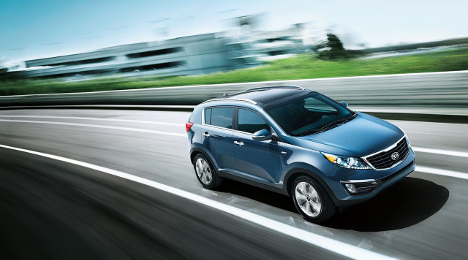New-model quality generates most improvement in 7 years

J.D. Power honored the Kia Sportage as the brand ranked highest in initial quality with a score of 83 PP100, according to the 2016 U.S. Initial Quality Study (IQS) released on Wednesday. (Photo courtesy of Kia)
When dealerships, finance companies and automotive experts discuss how much better vehicles are nowadays compared to 10 or 20 years ago, it’s not just a possible sales pitch or industry rallying cry.
With a South Korean badge leading the way, the J.D. Power 2016 U.S. Initial Quality Study (IQS) released on Wednesday showed that new-vehicle quality improved 6 percent, doubling the 3 percent rate of improvement in 2015 and registering the largest increase since 2009.
To recap, the study, now in its 30th year, examines problems experienced by vehicle owners during the first 90 days of ownership. Initial quality is determined by the number of problems experienced per 100 vehicles (PP100), with a lower score reflecting higher quality.
Analysts determined quality improved across all eight problem categories measured in the study, with 21 of the 33 brands included in the study improving their quality in 2016 and one remaining the same.
“Manufacturers are currently making some of the highest-quality products we’ve ever seen,” said Renee Stephens, vice president of U.S. automotive quality at J.D. Power.
“Tracking our data over the past several years, it has become clear that automakers are listening to the customer, identifying pain points and are focused on continuous improvement,” Stephens continued. “Even as they add more content, including advanced technologies that have had a reputation for causing problems, overall quality continues to improve.”
J.D. Power shared an infographic with further details, which can be found here.
Three other key findings for the latest study included:
• U.S. domestic automakers show strong improvement: For just the second time in the 30-year history of the study, U.S. domestic brands collectively have lower problem levels than all their import counterparts combined.
J.D. Power found that all three U.S. domestic automakers post year-over-year quality improvements. The “Detroit Three” achieve a combined average of 103 PP100, improving 10 percent from 2015, which is double the improvement rate of the import brands at 106 PP100.
The last time U.S. domestic brands outpaced imports was in 2010, when they held a 1 PP100 advantage (108 PP100 vs. 109 PP100, respectively).
• Non-premium brands have fewer problems: For the first time since 2006, non-premium brands have fewer problems (104 PP100) than premium brands (108 PP100).
• High quality equals high loyalty: Expected reliability remains the most important consideration when purchasing a new vehicle, cited by 49 percent of owners.
J.D. Power has studied consumer behavior from when they purchase or lease their new vehicle through when they are back in the market for their next vehicle in order to measure the impact initial quality has on brand loyalty. Among owners who experience no problems with their vehicle in the first 90 days, 54 percent stay with the same brand for their next vehicle.
Analysts mentioned loyalty drops to 50 percent among owners who experience one problem with their vehicle and to 45 percent among those who experience three or more problems.
“There is a direct correlation between the number of problems a customer has with their new vehicle and the decisions they make when it comes time to purchase or lease their next car or truck,” Stephens said. “While a small drop in actual loyalty may not sound like much, a percentage point drop in share can mean millions of dollars in lost revenue to an automaker.”
Highest-ranked nameplates and models
J.D. Power indicated Kia ranked highest in initial quality with a score of 83 PP100, the first time in 27 years that a non-premium brand has topped the rankings. It is also the second consecutive year that Kia, which ranked second in 2015, has led all non-premium makes in initial quality.
Porsche (84 PP100) ranked second among nameplates, followed by Hyundai (92 PP100), Toyota (93 PP100) and BMW (94 PP100).
Chrysler and Jeep were the most improved brands, each reducing the number of problems by 28 PP100 from 2015.
General Motors received seven model-level awards, followed by Toyota with six and Hyundai and Volkswagen each with four.
Of note among the specific models honored:
• GM models that rank highest in their respective segments are the Buick Cascada, Chevrolet Equinox, Chevrolet Silverado HD, Chevrolet Silverado LD, Chevrolet Spark, Chevrolet Tahoe and GMC Terrain.
• Toyota models that rank highest in their segment are the Lexus CT, Lexus GS, Scion tC, Toyota Camry, Toyota Corolla and Toyota Highlander.
• Hyundai models that rank highest in their segment are the Hyundai Accent; Hyundai Azera, Kia Soul and Kia Sportage.
• Volkswagen models that rank highest in their segment are the Audi Q3, Audi TT, Porsche Macan and Porsche 911.
The 2016 U.S. Initial Quality Study is based on responses from more than 80,000 purchasers and lessees of new 2016 model-year vehicles surveyed after 90 days of ownership. The study is based on a 233-question battery organized into eight problem categories designed to provide manufacturers with information to facilitate the identification of problems and drive product improvement. The study was fielded from February through May of this year.
For more information about the 2016 U.S. Initial Quality Study, visit this website.

 View The Latest Edition
View The Latest Edition

